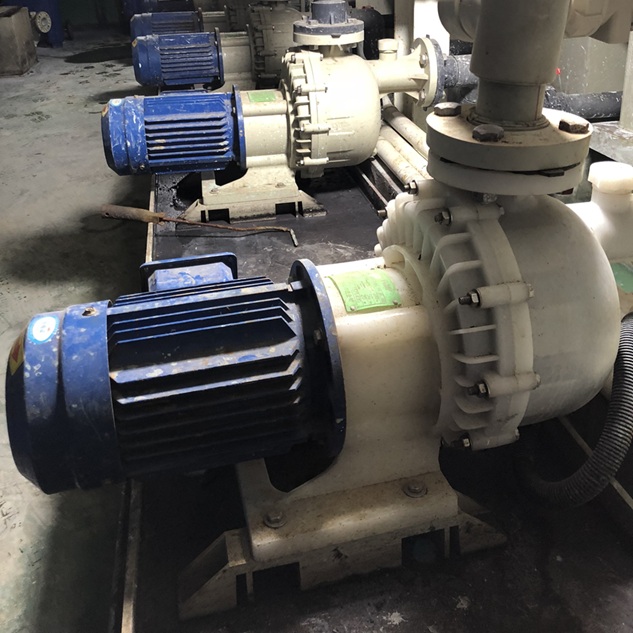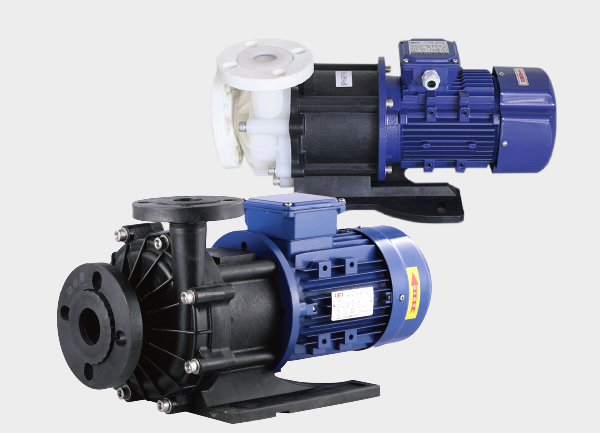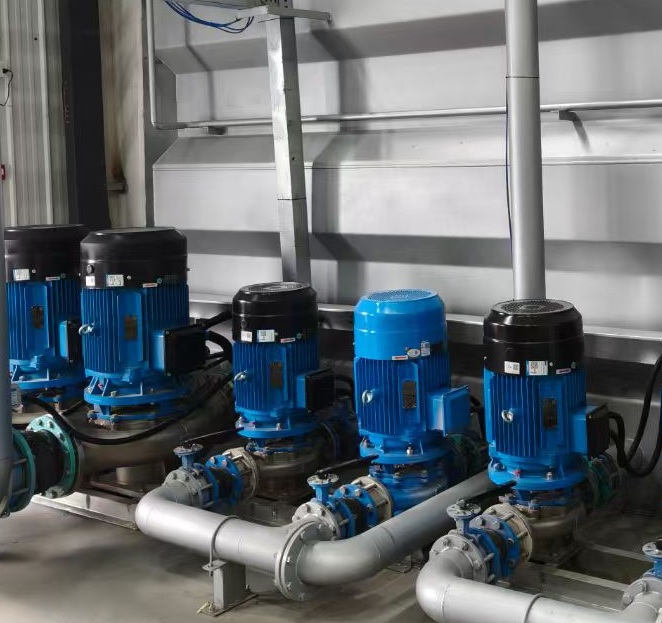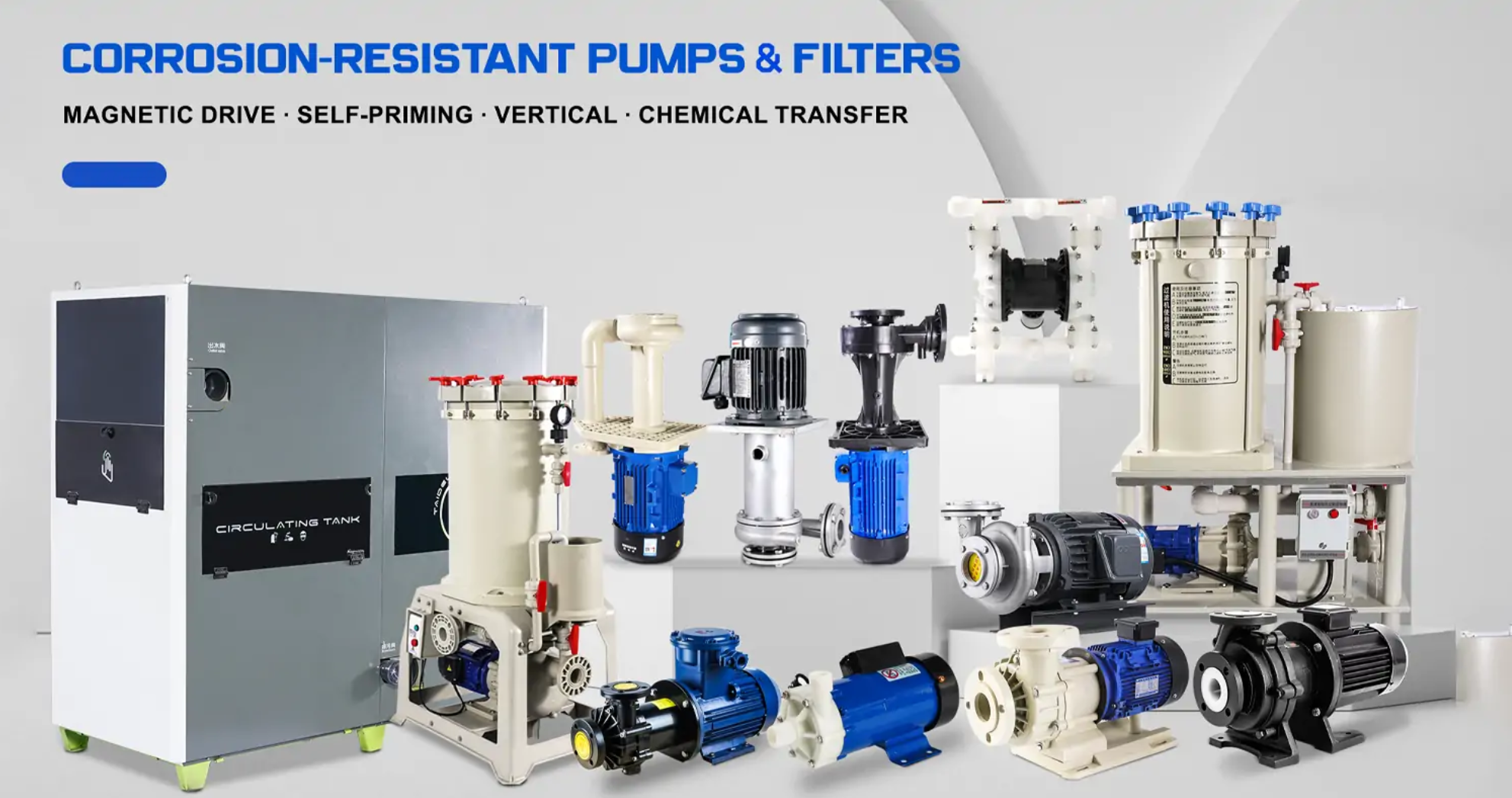In chemical production, the choice of transfer equipment directly affects both safety and efficiency. Among the most commonly used pumps are fluoroplastic chemical pumps and stainless steel chemical pumps. Their fundamental difference lies in the material of the wetted parts, which determines their corrosion resistance, applicable conditions, and overall performance. This article begins with the core advantages of fluoroplastic chemical pumps, then compares them with stainless steel chemical pumps to help guide selection in practical applications.
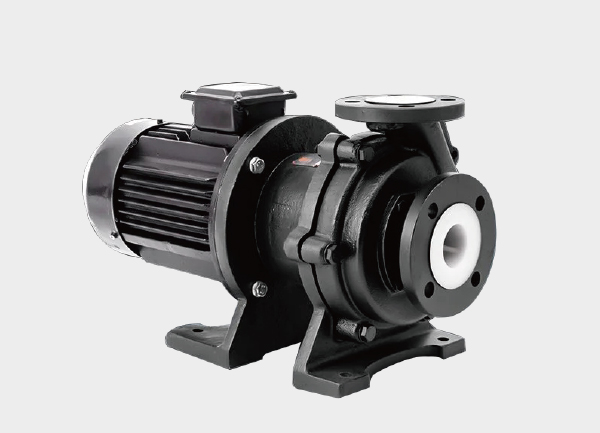
I. Core Advantages of Fluoroplastic Chemical Pumps
Fluoroplastic chemical pumps are designed for handling highly corrosive media. Their wetted components are made of fluoroplastics such as PTFE (Polytetrafluoroethylene), FEP (Perfluoroethylene Propylene, F46), and PVDF (Polyvinylidene Fluoride). These materials give the pumps distinct advantages in aggressive environments, summarized below:
1. Exceptional Corrosion Resistance – Ideal for Highly Corrosive Environments
This is the most defining advantage of fluoroplastic pumps. Fluoroplastics are chemically inert and do not react with most chemicals.
Wide resistance range: They can safely handle strong acids (e.g., concentrated nitric acid, hydrofluoric acid, fuming sulfuric acid), strong bases (e.g., concentrated NaOH, KOH), strong oxidizers (e.g., sodium hypochlorite, hydrogen peroxide), and various organic solvents (e.g., methanol, acetone). Only molten alkali metals and elemental fluorine can corrode them significantly.
Long-term stability: Under rated operating conditions, fluoroplastics resist aging, swelling, and embrittlement. This stability ensures consistent performance and reduces pump failures caused by corrosion.
2. Leak-Free Design – Safety and Environmental Protection
Handling corrosive media always carries high leakage risk. Most fluoroplastic chemical pumps are designed with leak-free structures to mitigate that risk.
Magnetic drive systems: Power is transmitted via magnetic coupling, completely isolating the pump chamber from the motor. This eliminates mechanical seal wear and prevents fluid leakage or vaporization, ensuring safe and environmentally compliant operation.
Reliable auxiliary sealing: When mechanical seals are used, they are combined with corrosion-resistant materials such as fluororubber (FKM) to further minimize leakage risk and enhance performance under medium-pressure or harsh conditions.
3. Broad Operating Flexibility – Suitable for Diverse Industrial Conditions
Beyond corrosion resistance, fluoroplastic pumps are versatile in temperature and process compatibility.
Moderate temperature tolerance: They can operate steadily between -20°C and 180°C (up to 200°C for certain PVDF models), handling both cryogenic liquids and medium-to-high temperature corrosive fluids.
Adaptable flow and head range: Available in various capacities and pressure configurations, they meet different process needs without frequent model replacement. Some types can even transfer fluids containing small amounts of solids when equipped with wear-resistant components.
4. Low Maintenance and Long Service Life – Reduced Total Cost
Low wear and easy cleaning: The smooth, non-stick surface of fluoroplastics prevents scaling and residue buildup, reducing internal wear and clogging.
Extended lifespan: With high resistance to corrosion and aging, key components such as the casing and impeller can last 5–8 years with proper maintenance—significantly longer than typical metal pumps—reducing replacement and downtime costs.
II. Key Differences Between Fluoroplastic and Stainless Steel Chemical Pumps
While fluoroplastic pumps focus on corrosion resistance, stainless steel chemical pumps (usually made of 304, 316, or 316L stainless steel) emphasize strength, temperature resistance, and mechanical reliability. Their differences can be summarized across several dimensions:
1. Material and Structural Design
Fluoroplastic Pump: All wetted parts are made of fluoroplastics; metallic frames (e.g., cast iron) are used only for external reinforcement. No metal is exposed to the process fluid.
Stainless Steel Pump: All wetted parts are stainless steel. Surface passivation or protective coatings are sometimes applied to enhance corrosion resistance.
2. Corrosion Resistance Comparison
| Aspect | Fluoroplastic Chemical Pump | Stainless Steel Chemical Pump |
|---|---|---|
| Corrosion Resistance | Broad-spectrum and extremely strong; resistant to nearly all common chemicals | Limited; depends on steel grade (304, 316, 316L, etc.) |
| Weaknesses | Molten alkali metals, elemental fluorine | Hydrofluoric acid, concentrated nitric acid, concentrated caustic soda, high-chloride media |
| Typical Applications | Concentrated HCl (>30%), fuming sulfuric acid, fluoride wastewater | Dilute sulfuric acid (<10%), food-grade liquids, pharmaceutical water |
3. Application Scenarios
Fluoroplastic Pumps: Ideal for highly corrosive or hazardous media, such as chemical waste, acid-base synthesis, or organic solvent transfer.
Stainless Steel Pumps: Suitable for weakly corrosive or neutral fluids, such as food processing, pharmaceutical water, cooling water circulation, or low-salinity solutions.
4. Operational Conditions
Temperature range:
Fluoroplastic: -20°C to 180°C (softens at higher temperatures).
Stainless steel: -196°C to 300°C (up to 1000°C for high-alloy types like 310S).
→ Stainless steel pumps are better for high-temperature applications (e.g., condensate or molten salts).
Pressure range:
Fluoroplastic: Best under medium or low pressure (≤1.6 MPa); deformation may occur at higher pressures.
Stainless steel: Suitable for high-pressure applications (up to 10 MPa, sometimes higher), such as high-pressure cleaning or reactor feed systems.
Media containing particles:
Fluoroplastic: Low hardness (Mohs 2–3), easily worn by solids.
Stainless steel: Higher hardness (~150 HB), more resistant to erosion, ideal for fluids with light solid content (e.g., low-concentration slurry).
5. Sealing and Safety
Fluoroplastic Pump: Predominantly magnetic-drive, leak-free systems with extremely low leakage risk—ideal for toxic or corrosive fluids.
Stainless Steel Pump: Usually employs mechanical seals; wear over time can cause micro-leaks. Double mechanical seals may be needed for hazardous fluids, increasing cost and complexity.
6. Cost and Service Life
Initial Cost: Fluoroplastic pumps (especially magnetic-drive types) are typically 2–5 times more expensive than stainless steel models due to material and manufacturing costs.
Total Cost of Ownership:
In strongly corrosive conditions, fluoroplastic pumps last 5–8 years with minimal maintenance, whereas stainless steel pumps may corrode within months.
In mildly corrosive or neutral conditions, stainless steel pumps offer a better cost-performance balance with lifespans of 3–5 years.
III. Selection Recommendations
For highly corrosive media (e.g., hydrofluoric acid, concentrated hydrochloric acid, caustic soda):
→ Choose fluoroplastic chemical pumps to eliminate corrosion and leakage risks.For weakly corrosive, neutral, or high-temperature/high-pressure fluids with mild abrasives:
→ Choose stainless steel chemical pumps — 304 for mild conditions, 316/316L for media with chloride ions.For mixed or uncertain media (e.g., chemical wastewater with variable composition):
→ Conduct material compatibility testing before selection, balancing initial investment and long-term maintenance costs for the most economical choice.




